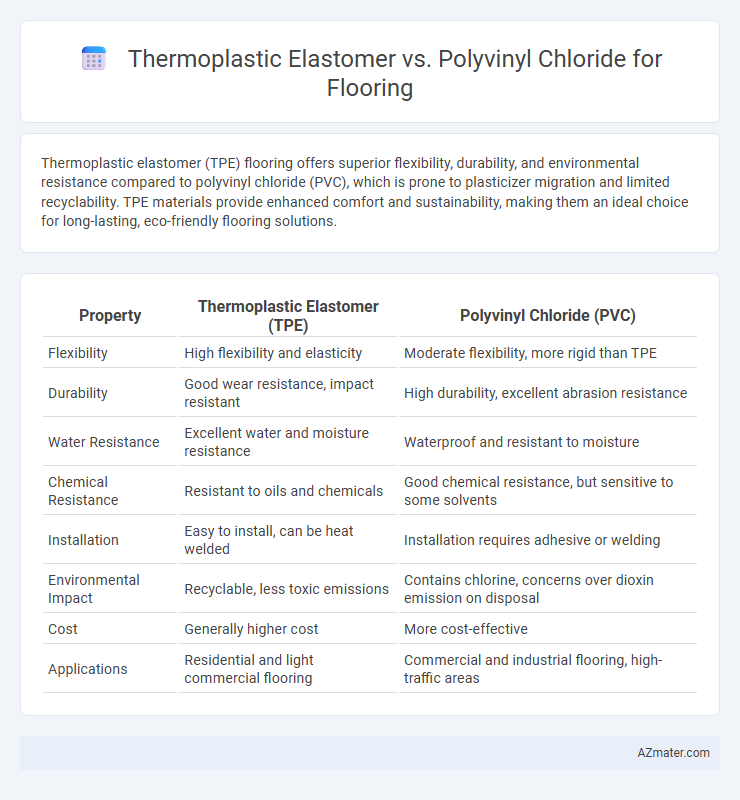Thermoplastic elastomer (TPE) flooring offers superior flexibility, durability, and environmental resistance compared to polyvinyl chloride (PVC), which is prone to plasticizer migration and limited recyclability. TPE materials provide enhanced comfort and sustainability, making them an ideal choice for long-lasting, eco-friendly flooring solutions.
Table of Comparison
| Property | Thermoplastic Elastomer (TPE) | Polyvinyl Chloride (PVC) |
|---|---|---|
| Flexibility | High flexibility and elasticity | Moderate flexibility, more rigid than TPE |
| Durability | Good wear resistance, impact resistant | High durability, excellent abrasion resistance |
| Water Resistance | Excellent water and moisture resistance | Waterproof and resistant to moisture |
| Chemical Resistance | Resistant to oils and chemicals | Good chemical resistance, but sensitive to some solvents |
| Installation | Easy to install, can be heat welded | Installation requires adhesive or welding |
| Environmental Impact | Recyclable, less toxic emissions | Contains chlorine, concerns over dioxin emission on disposal |
| Cost | Generally higher cost | More cost-effective |
| Applications | Residential and light commercial flooring | Commercial and industrial flooring, high-traffic areas |
Introduction to Thermoplastic Elastomer and Polyvinyl Chloride
Thermoplastic elastomers (TPE) combine the elastic properties of rubber with the recyclability and processability of plastics, making them versatile materials for flooring applications that require durability and flexibility. Polyvinyl chloride (PVC) is a widely used synthetic plastic polymer known for its toughness, chemical resistance, and affordability, often utilized in resilient flooring products like vinyl tiles and sheets. Both materials offer unique advantages in flooring, with TPE providing enhanced comfort and environmental benefits, while PVC delivers cost-effectiveness and a well-established performance record.
Material Composition and Properties
Thermoplastic elastomers (TPE) consist of a blend of polymers combining the elasticity of rubber with the processability of plastics, offering superior flexibility, resilience, and recyclability ideal for flooring. Polyvinyl chloride (PVC) is a synthetic plastic polymer characterized by rigidity that can be modified with plasticizers to enhance flexibility, but typically lacks the inherent elasticity and eco-friendly attributes of TPE. TPE flooring exhibits enhanced durability, resistance to wear, and environmental sustainability, while PVC flooring is noted for chemical resistance, affordability, and a broad range of finishes but may release volatile organic compounds (VOCs) over time.
Durability and Lifespan Comparison
Thermoplastic elastomer (TPE) flooring offers superior durability due to its high resistance to wear, UV exposure, and chemical damage, resulting in a lifespan of 15-20 years under heavy use. Polyvinyl chloride (PVC) flooring, while cost-effective and flexible, tends to degrade faster with a typical lifespan of 10-15 years, primarily due to susceptibility to cracking and discoloration under prolonged stress. The enhanced elasticity and impact resistance of TPE contribute to its longer-lasting performance in high-traffic environments compared to PVC alternatives.
Installation Methods for Flooring
Thermoplastic elastomer (TPE) flooring typically utilizes click-lock or loose lay installation methods, allowing for quick, glue-free application and easy replacement. Polyvinyl chloride (PVC) flooring often requires glue-down or heat-welding techniques to ensure a secure, moisture-resistant bond and seamless surface. The choice of installation method impacts durability, maintenance, and overall performance in commercial or residential flooring projects.
Comfort and Safety Underfoot
Thermoplastic elastomer (TPE) flooring offers superior comfort underfoot due to its elasticity and cushioning properties, reducing fatigue during prolonged standing. In contrast, polyvinyl chloride (PVC) flooring, while durable and water-resistant, tends to be firmer and less forgiving, which may contribute to discomfort over time. TPE's non-slip surface enhances safety by providing better traction, whereas PVC flooring requires additional treatments or coatings to improve slip resistance.
Environmental Impact and Sustainability
Thermoplastic elastomers (TPE) offer greater environmental benefits than polyvinyl chloride (PVC) flooring due to their recyclability and lower toxic chemical content, reducing landfill waste and harmful emissions. PVC production emits hazardous chemicals like dioxins, posing significant ecological and health risks, while TPEs are free of phthalates and chlorine, enhancing indoor air quality and sustainability. TPE flooring supports circular economy goals through easier reuse and recyclability, making it a more eco-friendly choice compared to conventional PVC.
Maintenance and Cleaning Requirements
Thermoplastic elastomer (TPE) flooring demands minimal maintenance, requiring simple regular sweeping and mopping with mild detergent to retain its flexibility and color. Polyvinyl chloride (PVC) floors need careful cleaning to avoid surface damage, often requiring specialized cleaners to prevent dulling or cracking over time. Both materials resist stains, but TPE generally outperforms PVC in longevity and ease of maintaining a clean, damage-free surface.
Aesthetic Options and Design Flexibility
Thermoplastic elastomers (TPE) offer a broader range of aesthetic options with vibrant colors, varied textures, and customizable finishes, enhancing design flexibility for flooring applications. Polyvinyl chloride (PVC) provides consistent patterns and traditional finishes but is generally less adaptable in bespoke design compared to TPE. The ability of TPE to mimic natural materials while maintaining durability makes it a preferred choice for innovative, visually appealing flooring solutions.
Cost Comparison and Value
Thermoplastic elastomer (TPE) flooring generally costs more upfront compared to polyvinyl chloride (PVC) flooring due to its enhanced flexibility, durability, and environmental benefits. PVC flooring offers a lower initial investment but may incur higher maintenance and replacement expenses over time because of its susceptibility to cracking and less eco-friendly composition. Evaluating the total cost of ownership, TPE provides better long-term value through longevity, resilience, and reduced environmental impact, making it a cost-effective choice for sustainable flooring solutions.
Ideal Applications and Final Recommendations
Thermoplastic elastomer (TPE) flooring excels in applications requiring flexibility, durability, and resistance to wear, making it ideal for gymnasiums, play areas, and commercial spaces with heavy foot traffic. Polyvinyl chloride (PVC) flooring is preferred for environments needing water resistance, chemical resistance, and ease of cleaning, such as healthcare facilities, kitchens, and bathrooms. For final recommendations, choose TPE for comfort and impact absorption in active settings and PVC for budget-friendly, low-maintenance solutions in moisture-prone areas.

Infographic: Thermoplastic elastomer vs Polyvinyl chloride for Flooring
 azmater.com
azmater.com